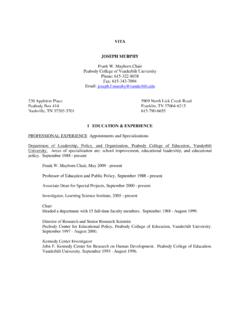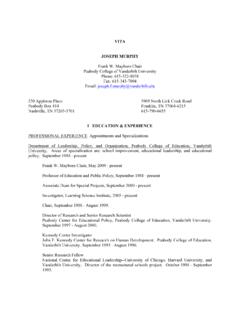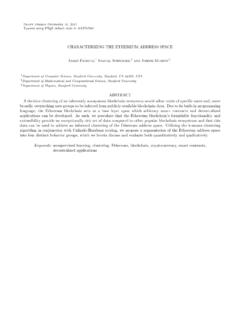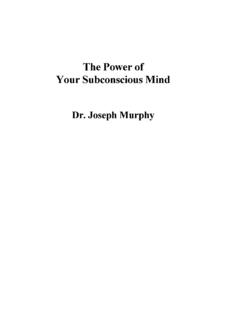Transcription of Reculturing Educational Leadership: The ISLLC …
1 Reculturing Educational leadership : The ISLLC standards Ten Years Out joseph murphy Vanderbilt University Paper prepared for the National Policy Board for Educational Administration September 2003 1 Over the last quarter century, the field of school administration has experienced considerable turmoil as it has struggled to grow out of its adolescence. During the last half of that time period, in ways that were rarely seen earlier in our profession, a good deal of energy has been invested in coming to grips with the question of what ideas should shape school administration in a post-theory era inside the academy and a post-industrial world for education writ large. This article chronicles the role of arguably the most significant reshaping initiative afoot in the profession during this time, the Interstate School Leaders Licensure Consortium ( ISLLC ) and outlines the design of its change engine, the ISLLC standards for School Leaders.
2 Although there is, by necessity, a bit of history in the narrative, it is not an historical story. Rather it is an analysis of a concerted effort to rebuild the foundations of school administration, both within the practice and academic domains of the profession. After a brief note on the formation of ISLLC , the article attends to two assignments: exposing the scaffolding that supports the standards and addressing critiques that have been directed at the standards and their use in the rebuilding process. A Note About ISLLC In order to understand the work of ISLLC , it is necessary to first introduce the National Commission for Excellence in Educational Administration (NCEEA) and the National Policy Board for Educational Administration (NPBEA). As we alluded to above, during the mid to late l980s the seeds of critique that had been planted in reaction to post-WWII reforms in Educational administration (see, for example, Culbertson, 1964; Erickson, 1977; Farquhar, 1968; Greenfield, 1975; Gregg, 1969; Harlow, 1962; Hills, 1975; Immegart, 1977) began to take root (Cooper & Boyd, 1987; Crowson & McPherson, 1987; Foster, 1984; Goldhammer, 1983; Griffiths, 1979, 1988) and long dormant censures of the profession s infatuation with all things corporate (see 2especially Newlon, 1934; Callahan, 1962) were resurrected (Bates, 1984; Sergiovanni, 1984).
3 Individual streams of criticism flowing from quite diverse sectors of the Educational administration terrain formed a powerful river of discontent (see murphy , 1990b; 1990c; 1990e; 1991a; 1992b for extended analysis of these dynamics as well as of change forces external to school administration in play at the end of the 1980s), one to which considerable new energy was added in the early 1990s (see especially a growing body of analysis from scholars employing more critical academic lenses such as Anderson, 1990; Donmoyer & Scheurich, 1994; Evans, 1991). The profession as a whole, up to this time comfortably complacent ((McCarthy, Kuh, Newell, & Iacona, 1988; murphy , 1991a), began to stir ( murphy , 1993a; murphy & Forsyth, 1999). Under the leadership of then-UCEA Executive Director, Patrick Forsyth, and the leading academic figure in the field of school administration at the time, Daniel Griffiths, the National Commission on Excellence in Educational Administration was formed to galvanize collective action on the challenges, opportunities, and problems confronting the field of school leadership .)
4 (See Forsyth, 1999, for an historical treatment of NCEEA.) While the legacy of this important marker in our history is yet to be determined, outcomes of the efforts of the NCEEA are visible throughout the field today ( murphy , 1999a). One of the most important of these is the existence of the NPBEA, a loosely yoked association of ten stakeholder organizations with major interests in school administration, including, from the academic section of the profession, AACTE, NCATE, NCPEA, and UCEA. (See Thomson, 1999, for a history of the NPBEA and its work.) The NPBEA, under the leadership of its then-Corporate Secretary, Scott Thomson, created ISLLC in 1994 to develop standards to anchor the profession as it headed into the 21st century. At its foundation, ISLLC was comprised of 24 states, most of the members of the 3 NPBEA, and other key stakeholder groups, such as the National Alliance of Business, with an interest in the health of leadership in America s schools and school districts.
5 In order to better link the standards work to the policy machinery of licensure and accreditation, ISLLC was housed at CCSSO. This move made additional sense because the Interstate New Teachers Assessment and Support Consortium (INTASC) which was working under the leadership of Linda Darling-Hammond to develop standards for teachers was already located at CCSSO. During its formative period, ISLLC was shaped by Scott Thomson, Corporate Secretary for the NPBEA; Ramsey Seldon, who had oversight responsibility for the project at CCSSO; and joseph murphy , Chair of the Consortium. As grant resources to fuel the project began to flow and the workload began to expand, Neil Shipman was hired as the full-time Executive Director to shepherd operations and Raymond Pechone, then-Director of Assessment for the State of Connecticut, was recruited to advise on the methodological and statistical dimensions of the Consortium s work.
6 Reculturing the Profession Although numerous sources may be cultivated, norms rooted in the ethos and culture of teaching as a profession provide the most effective basis for leadership in a school. (Greenfield, 1995, p. 75) A new leadership model must construe school leadership as being about students, learning, and teaching. (Donaldson, 2001, p. 30) Insofar as there is any empirical evidence on the frequency of actual instructional leadership in the work of school administrators, it points to a consistent pattern: direct involvement in instruction is among the least frequent activities performed by administrators of any kind at any level, and those who do engage in instructional leadership activities on a consistent basis are a relatively small proportion of the total administrative force. (Elmore, 2000, p.)
7 7) 4 The history of the early work of ISLLC and the remarkable leadership of a handful of dedicated state leaders is a fascinating narrative that has never been fully told, although it is partially explored elsewhere ( murphy & Shipman, 1999; 2002; 2003; murphy , Yff & Shipman, 2000). It is also beyond the purview of our assignment here. Our goal is narrower, , to explore how the Consortium labored to reshape school administration in the In order to undertake this assignment, it is important to examine the landscape the Consortium confronted in its quest to develop standards and to cobble together an array of strategies to use to bring those standards to life. The Existing Landscape The field of school administration was informed during its initial phase of development by ideas from philosophy and religion, which resulted in something akin to a doctrine of applied philosophy being introduced to the profession (Button, 1966; Callahan & Button, 1964; Moore, 1964).
8 Unfortunately, few of the ideas embedded in the ideal of the administrator as philosopher-educator from the 1800s found their way into the blueprints of the profession (Callahan, 1962; Farquhar, 1968; Harlow, 1962). Instead, school administration was constructed almost entirely on a two-layered foundation built up during the 19th century: concepts from management, especially from the private sector, and theories and constructs borrowed from the behavioral sciences. The idea of school leaders as business managers first surfaced during the early decades of the 20th century when the paramount hero in the larger society was corporate enterprise and its apotheosis, the CEO (Gregg, 1960; Newlon, 1934; Tyack & Hansot, 1982). This perspective has been reenergized and refined over the decades as each new idea from the corporate sector is held 5up as a tool or framework that school administrators should adopt ( , management by objectives, total quality management, benchmarking, 360 degree evaluation, and so forth).
9 After WWII, the mosaic of American society and the issues confronting school leaders began to change (Hencley, 1962; Norton, 1957; Watson, 1977). Scientists, not businesspeople, were held in highest regard (Halpin, 1960) and a quest for a science of administration in schools was engaged (Culbertson, 1964, 1965; Greenfield, 1988). Forged from withering attacks on the hortatory, seat-of-the pants literature already in place (Crowson & McPherson, 1987, pp. 447-48) and a movement away from techniques-oriented substance based on practical experience (Culbertson & Farquhar, 1971, p. 9; Halpin, 1957) and crafted from clamorings for more scientifically based underpinnings for the profession (Getzels, 1957; Griffiths, 1959; Grace, 1946; Halpin, 1960), knowledge blocks from the behavioral and social sciences were laid into the foundation of school administration.
10 While advocates of the behavioral sciences were somewhat successful in cementing a science of administration into the profession, historical reviews are much less sanguine about their efforts to dismantle the existing management pillars supporting school administration (Campbell, Fleming, Newell & Bennon, 1987; murphy , 1992b). Instead, what developed was a ladder-shaped structure for the profession, with one leg fostering the growth of ideas from management and the other leg nurturing the development of concepts from the social sciences. Anyone who seeks confirmation of this reality need look no further than the traditional curriculum that defines graduate study in school administration (see Table 1) courses, for the record, that are not informed by a vision for leading change to meet students needs (Fay, 1991, p.)













